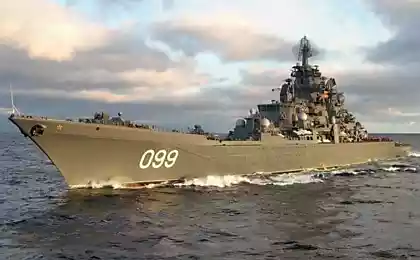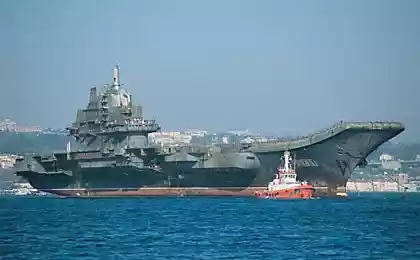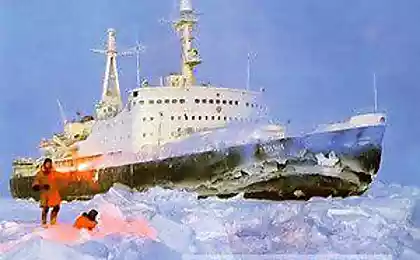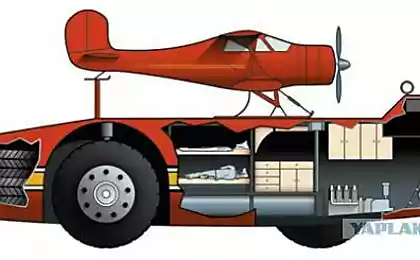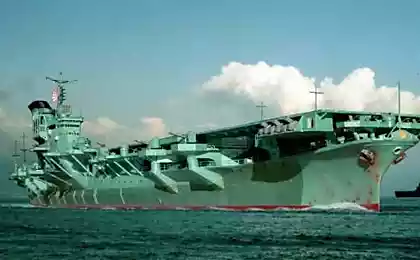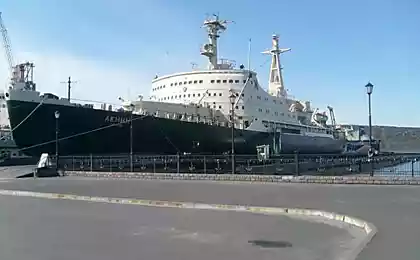1185
A new generation of nuclear-powered cruiser "Severodvinsk" (13 photos)
"Appropriate to the end of the test diving submarine" Severodvinsk "means, according to some experts that Russia pulled ahead in submarine technology.»
From the report Sandy Times
All of you have already heard that the Navy of the Russian Federation in late 2013 was a new generation of nuclear-powered cruiser "Severodvinsk". The appearance of a Russian military equipment has not gone unnoticed: Russia seized the technological leadership in the global submarine fleet, says the London newspaper Sandy Times.
Russian submarine will be able to strike not only the ships and submarines of the enemy, but also in coastal targets. Already coming spring, according to the British edition, will be completed trial operation "Severodvinsk" submarine and intercede on combat duty in the Arctic.
On assurances of experts "Sevmash", "Severodvinsk" is not inferior to its characteristics and the most modern armament American and British submarines "Sea Wolf" and "Astityut." It seems that this fact is particularly worried about the United States. Newspaper Sandy Times, quoting sources from the intelligence services, notes that in the West do not know the half of what is on the board "Severodvinsk».
Let's learn more about this project, which began in the late 70s


In the twenty years that have passed since the bookmarks in the project made a lot of changes in order to bring it into line with modern technical requirements. However, the concept of the project raises questions about the justification for the serial construction of submarines of Project 885 "Ash" threatens to be too expensive and excessively powerful in modern conditions.
The development of a new generation of submarine started in the USSR in the late 70s. Initially, it was adopted in the framework of earlier concept of development of the submarine fleet, involves the construction of each generation of several types of specialized submarines: strategic protivoavianosnyh, multi-purpose and special purpose. As a fighter aircraft carrier, which was supposed to be in the 90s to replace the shipyards Project 949A submarines "Antey" developed the project 881 "Mercury", which threatened to become the largest non-strategic submarines in the world (a displacement of 25,000 tons). In the role of "Hunter", designed primarily for anti-submarine warfare, planned to use Project 957 "Cedar". But in the second half of the 80s, it became clear that the simultaneous construction of such a large number of projects (recall that separately developed special purpose boats and "Strategy"), too much for the Soviet Union. We are talking about the new project, which would replace and "Mercury" and "Cedar". Such a project is protected at the end of the 80s, the number was 885, and the code "Ash". By the end of 1991 it was completed the formation of a technical person perspective submarine. This speed was due to a large volume of developments obtained during the design of nuclear submarines of the 3rd generation - projects 971 and 949, as well as the development of rejection in favor of "Ash" themes of the 4th generation.

Foreign influence
An undeniable influence on the "Ash" was the appearance in the United States the second series of multi-purpose boat type Los Angeles. Since the SSN-719 Providence, these submarines were equipped with vertical launchers Mk 36, 12 mines had to cruise missiles Tomahawk. The same settings are received and advanced submarine type Improved Los Angeles.
In addition, in 1989 the United States began construction of the first submarine type Seawolf, whose number SSN-21 talked about the US claim to create a submarine of the XXI century. Vertical launchers of this boat, however, did not have, but had increased 8 torpedo tubes caliber (660 mm instead of 533). In addition to the standard launch missiles and torpedoes of 533 mm caliber (which have to be loaded in transport-launch containers), they were to be used to start the manned and unmanned underwater vehicles, which dramatically increases the ability of submarines. Total ammunition Seawolf was 50 units of cruise missiles, torpedoes, rockets, torpedoes. "Sea Wolves" became large submarines - their displacement exceeding 9,000 tonnes. According to the plans drawn up even under Ronald Reagan, it was assumed that the Navy will receive 90-early 2000s, thirty of these submarines, which will replace the outdated type submarine Sturgeon, and early Los Angeles. The main advantage of Seawolf addition to versatility, is their low noise, despite the seemingly nesposobstvuyuschy this growth in size: the boat got new water jets and nuclear power plants of a new design that has allowed sharply lower noise at speeds up to 20 knots. Boats previous generations started making noise already at half speed.

Works on the background of the collapse of
Finalization of the technical aspect of the project 885, which is also planned to multiply in an amount of 30 units were in 1991. Even then it was clear that with the construction of production boats will be problems, but the plant in Severodvinsk has already begun production of the first elements of hull structures for the "Ash". Bookmark the head of the submarine was held at the 55th workshop of Sevmash December 21, 1993. Head housing project 885, serial number 160, received tactical number K-329 and the name "Severodvinsk" in honor of its cradle.
Future "wagon" of the Russian submarine fleet, as well as the Seawolf, has turned out rather big. Standard displacement of the project is 9700 885 tonnes, total - more than 13,500 tons. It has high speed travel (up to 33 nodes on a number of sources), and has a powerful torpedo armament: 10 torpedo tubes caliber of 533 mm. The main trump card "Severodvinsk" was his Missiles: 8 vertical launchers mine type, each of which can be taken up to four cruise missiles of various classes. In fact, the project was the first type 885 submarines, which received universal vertical launch installation: these mines can be supersonic anti-ship "Onyx" strategic "Grenades" and the whole range of the missile complex "Caliber". In addition, for the first time in the Soviet practice on the series planned to install a submarine sonar system "Irtysh" with the spherical antenna of large diameter "Amphora". This equipment has got "Ash" inherited from yet another late-unrealized project - boats and sonar watch the underwater environment of the project 958 "Bottlenose Dolphin". In addition to the areas forced to remove torpedo from under the nose fairing in the first compartment with the conclusion of the board in the "American style", the project has received from the 885 "dolphin" is also on-board antenna large area. This decision has pledged unprecedented growth opportunities for the discovery of the boat under water purposes.
Meanwhile, work on the 160-m order Sevmash due to chronic underfunding walked very slowly. In 1996, when the "Severodvinsk" is already planned down to the water, they have stopped almost completely. Boat stuck on the stocks of the two disparate sections of the hull without the equipment. Date of launch has been postponed to 2000, then for 2005.

Overseas: change the concept
The collapse of the Soviet Union and the subsequent repeated cuts in military spending in Russia has deprived the US Navy's main enemy, and against this background, the need for construction of a large series of submarine Seawolf, the price of which was close to three billion dollars per unit, was called into question. Order boat type SSN-21 was reduced first to 12 units, and in 1995 decided to limit a series of three boats, the latter - SSN-23 Jimmy Carter added two on a special project. Marine received an additional compartment (its length is thus increased from 108 to 138 meters), equipped to run a mini-submarines and remotely operated vehicles, larger than those that could be run through a 660-mm torpedo tubes. Remodeled so that the boat is used to perform special tasks, including reconnaissance. The cost of Seawolf boats series resulting from the reduction of up to three units has increased to more than $ 4 billion. Even before, in 1991, in the United States have begun work on a new project, code name Centurion.
This project was supposed to give an alternative to the US Navy's Seawolf - a relatively cheap multi-purpose submarines, not record different performance characteristics, but having modern equipment and capable in the long term replace Los Angeles. Soon, when the requirements for the submarine became clearer, the project was designated NSSN - New SSN, a new nuclear submarine. Displacement of a new submarine limited 7,000 tons, the estimated price per unit - 1, 8 billion dollars.
The new submarine was to be even slightly lower full speed than Los Angeles (not less than 25 knots on the technical task against more than 30 of its predecessor). At the same time, the new sonar equipment and noise reduction had to do NSSN more advanced underwater hunter. From the outset supposed to NSSN and great features special operations - by having a special airlock to exit frogmen and the possibility of mounting a mini-submarine ASDS, but on this unit US Navy subsequently refused.
Anyway, the head of the boat building project NSSN began in 2000. The submarine was designated SSN-774 Virginia. Boats first series of cost is quite expensive - more than 2, 5 billion dollars per unit. Currently, the price of the submarine went down to a small two billion dollars, with inflation of the last 20 years in general close to the planned 1, 8. Construction and equipment of the submarine when it is improved.

Test launch of KR 3M14 "Caliber" with submarines K-329 "Severodvinsk" pr.885
Price «Severodvinsk»
Work on the promising Russian submarine resumed in the early 2000s, when military expenditure started to rise again. And almost immediately it became clear that the project must be processed - both in terms of progress in the development of equipment and taking into account the changed capabilities of industry and the need to reduce supplies from the former Soviet Union. Marine received the latest automated system of command and control (ASBU) "District" was completely updated electronic sonar system and so on. However, on the lead ship was unable to establish a nuclear power plant with a new type of reactor KTP-6, the service life is without changing the core must be at least 30 years. As a result, the head "Ash" was reactor OK-650V is already spent on a submarine project 971, 949A, and other third-generation projects. The new power plant will be on a project with only 885 of the second body, pledged in 2009 under the name "Kazan».
One of the main inter-agency conflicts in Russia in 2011 was a dispute between the Ministry of Defense and defense industry over the price of nuclear-powered submarines. Among other things, the parties could not agree on the price of the boat 885. The lead ship of the project was estimated at 47 billion rubles, while a significant portion of its hull structures made in the USSR, the price of the new boats that had to build from scratch, has exceeded one hundred billion rubles . As a result, Mnnoborony achieved by the United Shipbuilding Corporation reduce prices, but the figures are 40 and even 30 billion rubles periodically flashing in the press do not cause confidence. Some experts estimate the value of the serial "Severodvinsk" 80-90 billion.
Thus today Russia has a total ease of 27 non-strategic nuclear submarines of project 971, 945, and 949A 671RTM. The average age of these submarines is more than 20 years, and over the next fifteen years, most of them will be charged for the physical wear and tear. Taking this into consideration, to be built in Russia before the end of the 2020s at least 20 nuclear submarines in order to prevent the reduction of the existing number of submarines, while increasing the combat readiness of the submarine fleet. At present, the state armaments program for 2011-2020 envisages the construction of eight submarines of Project 885 / 885M and the possibility to increase this number to 20 by 2028 is not very realistic.
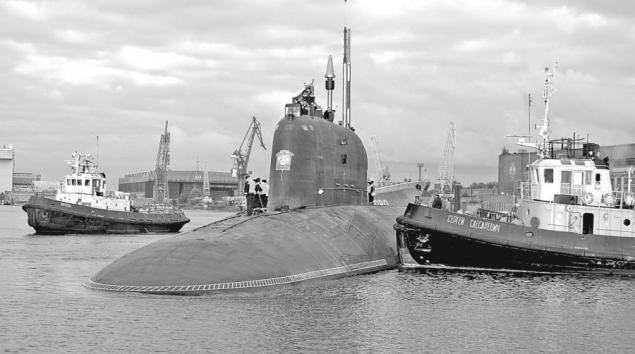
Reincarnation "Pike»?
An example of a relatively inexpensive, but at the same time very efficient and multi-purpose submarines perfected in domestic practice is already there: it projects SSN 671, 671RT, RTM / RTMK known in the West under the NATO designations Victor I, II and III respectively. 47 submarines of this type are included in the Navy from 1967 to 1992, it became the main "workhorse" podplava 70-90-ies. They are reliable, simple design and thus were quite perfect: it was with the advent of "Victoria" American and British strategic missile no longer feel safe. Low noise design 671 and continuously updated equipment provides these boats a good chance in the underwater confrontation that has been proven, in particular, the success of the operation "Sic" and "Katrin", conducted in 1985 and 1987, as well as in numerous routine combat duty Navy . This is especially true of the third generation submarines of this project - 671RTM / RTMK "Pike».
The relatively small size of the boat, "reasonable moderation" in the service in conjunction with modern equipment provide a concept from which to push off, as is done in the United States as an example of boats such as Virginia. Considering smaller than the United States, the economic possibilities of Russia, the repetition of this experience, particularly in view of the existing two examples before his eyes, looks very tempting. Under these conditions it seems reasonable to limit the construction of the "Ash" series of no more than 4-6 units, given the fact that boats with more rocket ammo still need the fleet. As the main project, whose construction should start no later than the 2017-2018 year to build by 2030 at least 15 new submarines, should consider establishing a "cheap" "Ash" reduced to 6, 5-7 thousand tons displacement and less powerful weapons. This boat can carry up to four universal launchers (16 missiles) and 4-6 torpedo tubes instead of 8 and 10 in the "Ash", respectively. Such a move will equip the fleet by the end of the next decade, a sufficient number of new nuclear submarines, in order to compensate for the withdrawal of Soviet submarine construction, without incurring unnecessary costs.

The history of nuclear submarines accepted happened four times, each of which reflects a crucial change in the views of the military theories of the use and effectiveness of the arms, the results of scientific and technological progress and the emergence of new technologies - and, as a consequence, a radical increase in the combat capabilities of nuclear submarines.
First generation submarines, despite the endless possibilities in comparison with "dizelyuhami" were largely experimental technique - an extremely inconvenient and dangerous to operate ships with imperfect structure and arms. The legendary "Nautilus", the firstborn of the Soviet K-3 "Leninsky Komsomol" sinister K-19 - that they are the first generation atomarin.
The accumulation of operating experience of nuclear power plants, a significant scientific and industrial progress in shipbuilding, electronics, precision engineering - all this ultimately led to the emergence of the next Premier League, the second generation. Markedly increased the speed and depth of the submarine sonar systems have new, radically enhance the ability to control the surrounding area.
The third generation nuclear submarines are characterized by high standardization and unification of systems: Soviet industry to develop a single powerplant for all future projects of submarine-based reactor OK-650, and the Americans finally moved to large-scale construction of just two projects: strategic and multi-purpose submarines. Atomariny increased significantly in size, submerged displacement of the legendary "shark" - strategic missile project has reached 50 941 000 tons!
"The killer of aircraft carriers" K-141 "Kursk" submarine cruisers of strategic purpose of the project 667BDRM American "Los Angeles" and "Ohio" British "Trafalgar" and "Vanguard" - submarines of the third generation is still the basis of the submarine fleet all developed countries.
It is worth noting that due to the difference in views on the use of the Navy, as well as due to the peculiarities of national defense industry and emergency "spread" in time, the submarine one "generation" great differ. Sometimes it is difficult to determine the identity atomariny to any particular 'generation', each project has its own individual characteristics, important advantages and disadvantages.

The central position of the submarine USS Seawolf (SSN-21), relating to the fourth generation
For example, the Americans have achieved phenomenal success in the field of safety of nuclear power plants.
From the report Sandy Times
All of you have already heard that the Navy of the Russian Federation in late 2013 was a new generation of nuclear-powered cruiser "Severodvinsk". The appearance of a Russian military equipment has not gone unnoticed: Russia seized the technological leadership in the global submarine fleet, says the London newspaper Sandy Times.
Russian submarine will be able to strike not only the ships and submarines of the enemy, but also in coastal targets. Already coming spring, according to the British edition, will be completed trial operation "Severodvinsk" submarine and intercede on combat duty in the Arctic.
On assurances of experts "Sevmash", "Severodvinsk" is not inferior to its characteristics and the most modern armament American and British submarines "Sea Wolf" and "Astityut." It seems that this fact is particularly worried about the United States. Newspaper Sandy Times, quoting sources from the intelligence services, notes that in the West do not know the half of what is on the board "Severodvinsk».
Let's learn more about this project, which began in the late 70s


In the twenty years that have passed since the bookmarks in the project made a lot of changes in order to bring it into line with modern technical requirements. However, the concept of the project raises questions about the justification for the serial construction of submarines of Project 885 "Ash" threatens to be too expensive and excessively powerful in modern conditions.
The development of a new generation of submarine started in the USSR in the late 70s. Initially, it was adopted in the framework of earlier concept of development of the submarine fleet, involves the construction of each generation of several types of specialized submarines: strategic protivoavianosnyh, multi-purpose and special purpose. As a fighter aircraft carrier, which was supposed to be in the 90s to replace the shipyards Project 949A submarines "Antey" developed the project 881 "Mercury", which threatened to become the largest non-strategic submarines in the world (a displacement of 25,000 tons). In the role of "Hunter", designed primarily for anti-submarine warfare, planned to use Project 957 "Cedar". But in the second half of the 80s, it became clear that the simultaneous construction of such a large number of projects (recall that separately developed special purpose boats and "Strategy"), too much for the Soviet Union. We are talking about the new project, which would replace and "Mercury" and "Cedar". Such a project is protected at the end of the 80s, the number was 885, and the code "Ash". By the end of 1991 it was completed the formation of a technical person perspective submarine. This speed was due to a large volume of developments obtained during the design of nuclear submarines of the 3rd generation - projects 971 and 949, as well as the development of rejection in favor of "Ash" themes of the 4th generation.

Foreign influence
An undeniable influence on the "Ash" was the appearance in the United States the second series of multi-purpose boat type Los Angeles. Since the SSN-719 Providence, these submarines were equipped with vertical launchers Mk 36, 12 mines had to cruise missiles Tomahawk. The same settings are received and advanced submarine type Improved Los Angeles.
In addition, in 1989 the United States began construction of the first submarine type Seawolf, whose number SSN-21 talked about the US claim to create a submarine of the XXI century. Vertical launchers of this boat, however, did not have, but had increased 8 torpedo tubes caliber (660 mm instead of 533). In addition to the standard launch missiles and torpedoes of 533 mm caliber (which have to be loaded in transport-launch containers), they were to be used to start the manned and unmanned underwater vehicles, which dramatically increases the ability of submarines. Total ammunition Seawolf was 50 units of cruise missiles, torpedoes, rockets, torpedoes. "Sea Wolves" became large submarines - their displacement exceeding 9,000 tonnes. According to the plans drawn up even under Ronald Reagan, it was assumed that the Navy will receive 90-early 2000s, thirty of these submarines, which will replace the outdated type submarine Sturgeon, and early Los Angeles. The main advantage of Seawolf addition to versatility, is their low noise, despite the seemingly nesposobstvuyuschy this growth in size: the boat got new water jets and nuclear power plants of a new design that has allowed sharply lower noise at speeds up to 20 knots. Boats previous generations started making noise already at half speed.

Works on the background of the collapse of
Finalization of the technical aspect of the project 885, which is also planned to multiply in an amount of 30 units were in 1991. Even then it was clear that with the construction of production boats will be problems, but the plant in Severodvinsk has already begun production of the first elements of hull structures for the "Ash". Bookmark the head of the submarine was held at the 55th workshop of Sevmash December 21, 1993. Head housing project 885, serial number 160, received tactical number K-329 and the name "Severodvinsk" in honor of its cradle.
Future "wagon" of the Russian submarine fleet, as well as the Seawolf, has turned out rather big. Standard displacement of the project is 9700 885 tonnes, total - more than 13,500 tons. It has high speed travel (up to 33 nodes on a number of sources), and has a powerful torpedo armament: 10 torpedo tubes caliber of 533 mm. The main trump card "Severodvinsk" was his Missiles: 8 vertical launchers mine type, each of which can be taken up to four cruise missiles of various classes. In fact, the project was the first type 885 submarines, which received universal vertical launch installation: these mines can be supersonic anti-ship "Onyx" strategic "Grenades" and the whole range of the missile complex "Caliber". In addition, for the first time in the Soviet practice on the series planned to install a submarine sonar system "Irtysh" with the spherical antenna of large diameter "Amphora". This equipment has got "Ash" inherited from yet another late-unrealized project - boats and sonar watch the underwater environment of the project 958 "Bottlenose Dolphin". In addition to the areas forced to remove torpedo from under the nose fairing in the first compartment with the conclusion of the board in the "American style", the project has received from the 885 "dolphin" is also on-board antenna large area. This decision has pledged unprecedented growth opportunities for the discovery of the boat under water purposes.
Meanwhile, work on the 160-m order Sevmash due to chronic underfunding walked very slowly. In 1996, when the "Severodvinsk" is already planned down to the water, they have stopped almost completely. Boat stuck on the stocks of the two disparate sections of the hull without the equipment. Date of launch has been postponed to 2000, then for 2005.

Overseas: change the concept
The collapse of the Soviet Union and the subsequent repeated cuts in military spending in Russia has deprived the US Navy's main enemy, and against this background, the need for construction of a large series of submarine Seawolf, the price of which was close to three billion dollars per unit, was called into question. Order boat type SSN-21 was reduced first to 12 units, and in 1995 decided to limit a series of three boats, the latter - SSN-23 Jimmy Carter added two on a special project. Marine received an additional compartment (its length is thus increased from 108 to 138 meters), equipped to run a mini-submarines and remotely operated vehicles, larger than those that could be run through a 660-mm torpedo tubes. Remodeled so that the boat is used to perform special tasks, including reconnaissance. The cost of Seawolf boats series resulting from the reduction of up to three units has increased to more than $ 4 billion. Even before, in 1991, in the United States have begun work on a new project, code name Centurion.
This project was supposed to give an alternative to the US Navy's Seawolf - a relatively cheap multi-purpose submarines, not record different performance characteristics, but having modern equipment and capable in the long term replace Los Angeles. Soon, when the requirements for the submarine became clearer, the project was designated NSSN - New SSN, a new nuclear submarine. Displacement of a new submarine limited 7,000 tons, the estimated price per unit - 1, 8 billion dollars.
The new submarine was to be even slightly lower full speed than Los Angeles (not less than 25 knots on the technical task against more than 30 of its predecessor). At the same time, the new sonar equipment and noise reduction had to do NSSN more advanced underwater hunter. From the outset supposed to NSSN and great features special operations - by having a special airlock to exit frogmen and the possibility of mounting a mini-submarine ASDS, but on this unit US Navy subsequently refused.
Anyway, the head of the boat building project NSSN began in 2000. The submarine was designated SSN-774 Virginia. Boats first series of cost is quite expensive - more than 2, 5 billion dollars per unit. Currently, the price of the submarine went down to a small two billion dollars, with inflation of the last 20 years in general close to the planned 1, 8. Construction and equipment of the submarine when it is improved.

Test launch of KR 3M14 "Caliber" with submarines K-329 "Severodvinsk" pr.885
Price «Severodvinsk»
Work on the promising Russian submarine resumed in the early 2000s, when military expenditure started to rise again. And almost immediately it became clear that the project must be processed - both in terms of progress in the development of equipment and taking into account the changed capabilities of industry and the need to reduce supplies from the former Soviet Union. Marine received the latest automated system of command and control (ASBU) "District" was completely updated electronic sonar system and so on. However, on the lead ship was unable to establish a nuclear power plant with a new type of reactor KTP-6, the service life is without changing the core must be at least 30 years. As a result, the head "Ash" was reactor OK-650V is already spent on a submarine project 971, 949A, and other third-generation projects. The new power plant will be on a project with only 885 of the second body, pledged in 2009 under the name "Kazan».
One of the main inter-agency conflicts in Russia in 2011 was a dispute between the Ministry of Defense and defense industry over the price of nuclear-powered submarines. Among other things, the parties could not agree on the price of the boat 885. The lead ship of the project was estimated at 47 billion rubles, while a significant portion of its hull structures made in the USSR, the price of the new boats that had to build from scratch, has exceeded one hundred billion rubles . As a result, Mnnoborony achieved by the United Shipbuilding Corporation reduce prices, but the figures are 40 and even 30 billion rubles periodically flashing in the press do not cause confidence. Some experts estimate the value of the serial "Severodvinsk" 80-90 billion.
Thus today Russia has a total ease of 27 non-strategic nuclear submarines of project 971, 945, and 949A 671RTM. The average age of these submarines is more than 20 years, and over the next fifteen years, most of them will be charged for the physical wear and tear. Taking this into consideration, to be built in Russia before the end of the 2020s at least 20 nuclear submarines in order to prevent the reduction of the existing number of submarines, while increasing the combat readiness of the submarine fleet. At present, the state armaments program for 2011-2020 envisages the construction of eight submarines of Project 885 / 885M and the possibility to increase this number to 20 by 2028 is not very realistic.

Reincarnation "Pike»?
An example of a relatively inexpensive, but at the same time very efficient and multi-purpose submarines perfected in domestic practice is already there: it projects SSN 671, 671RT, RTM / RTMK known in the West under the NATO designations Victor I, II and III respectively. 47 submarines of this type are included in the Navy from 1967 to 1992, it became the main "workhorse" podplava 70-90-ies. They are reliable, simple design and thus were quite perfect: it was with the advent of "Victoria" American and British strategic missile no longer feel safe. Low noise design 671 and continuously updated equipment provides these boats a good chance in the underwater confrontation that has been proven, in particular, the success of the operation "Sic" and "Katrin", conducted in 1985 and 1987, as well as in numerous routine combat duty Navy . This is especially true of the third generation submarines of this project - 671RTM / RTMK "Pike».
The relatively small size of the boat, "reasonable moderation" in the service in conjunction with modern equipment provide a concept from which to push off, as is done in the United States as an example of boats such as Virginia. Considering smaller than the United States, the economic possibilities of Russia, the repetition of this experience, particularly in view of the existing two examples before his eyes, looks very tempting. Under these conditions it seems reasonable to limit the construction of the "Ash" series of no more than 4-6 units, given the fact that boats with more rocket ammo still need the fleet. As the main project, whose construction should start no later than the 2017-2018 year to build by 2030 at least 15 new submarines, should consider establishing a "cheap" "Ash" reduced to 6, 5-7 thousand tons displacement and less powerful weapons. This boat can carry up to four universal launchers (16 missiles) and 4-6 torpedo tubes instead of 8 and 10 in the "Ash", respectively. Such a move will equip the fleet by the end of the next decade, a sufficient number of new nuclear submarines, in order to compensate for the withdrawal of Soviet submarine construction, without incurring unnecessary costs.

The history of nuclear submarines accepted happened four times, each of which reflects a crucial change in the views of the military theories of the use and effectiveness of the arms, the results of scientific and technological progress and the emergence of new technologies - and, as a consequence, a radical increase in the combat capabilities of nuclear submarines.
First generation submarines, despite the endless possibilities in comparison with "dizelyuhami" were largely experimental technique - an extremely inconvenient and dangerous to operate ships with imperfect structure and arms. The legendary "Nautilus", the firstborn of the Soviet K-3 "Leninsky Komsomol" sinister K-19 - that they are the first generation atomarin.
The accumulation of operating experience of nuclear power plants, a significant scientific and industrial progress in shipbuilding, electronics, precision engineering - all this ultimately led to the emergence of the next Premier League, the second generation. Markedly increased the speed and depth of the submarine sonar systems have new, radically enhance the ability to control the surrounding area.
The third generation nuclear submarines are characterized by high standardization and unification of systems: Soviet industry to develop a single powerplant for all future projects of submarine-based reactor OK-650, and the Americans finally moved to large-scale construction of just two projects: strategic and multi-purpose submarines. Atomariny increased significantly in size, submerged displacement of the legendary "shark" - strategic missile project has reached 50 941 000 tons!
"The killer of aircraft carriers" K-141 "Kursk" submarine cruisers of strategic purpose of the project 667BDRM American "Los Angeles" and "Ohio" British "Trafalgar" and "Vanguard" - submarines of the third generation is still the basis of the submarine fleet all developed countries.
It is worth noting that due to the difference in views on the use of the Navy, as well as due to the peculiarities of national defense industry and emergency "spread" in time, the submarine one "generation" great differ. Sometimes it is difficult to determine the identity atomariny to any particular 'generation', each project has its own individual characteristics, important advantages and disadvantages.

The central position of the submarine USS Seawolf (SSN-21), relating to the fourth generation
For example, the Americans have achieved phenomenal success in the field of safety of nuclear power plants.

